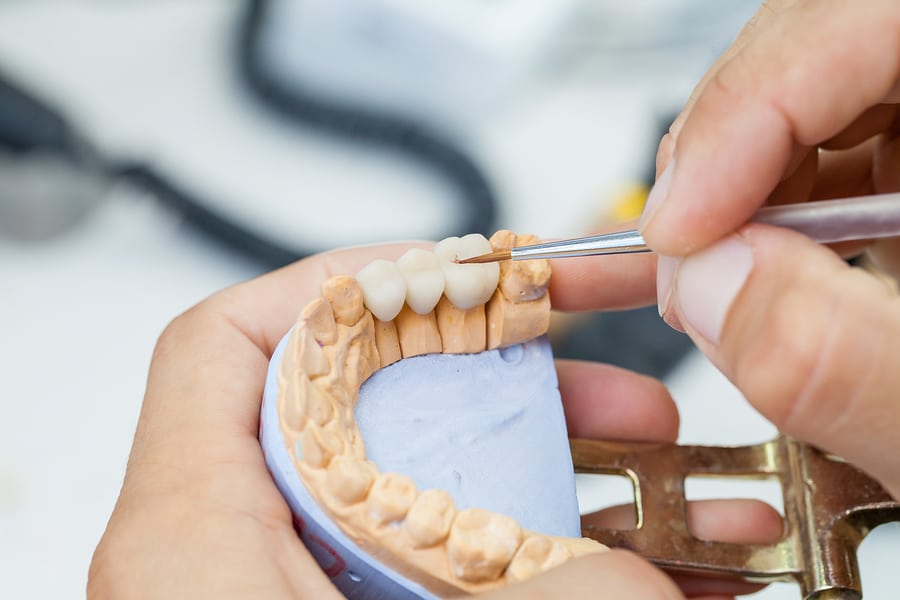Your smile can be your best accessory. When your oral health is suffering, you may feel like there isn’t much to smile about. If you are one of the many people that is dealing with the loss of a tooth there is good news! There are many options available to replace what was lost and maintain your beautiful smile.
Benefits of Dental Bridges
Dental bridges are used to bridge the gap caused by missing teeth. Bridges help properly distribute the force of chewing and help you keep your remaining natural teeth in place. They can also prevent bone loss and as a result, help maintain the shape of your face. All of this is in addition to the cosmetic benefits of filling out your smile which will give you greater confidence in the appearance of your teeth.
Types of Dental Bridges
A dental bridge is a viable solution for many different situations. A bridge is comprised of a fake tooth to replace the one that was lost and various mechanisms to hold the fake tooth in place. If you are considering this procedure, there are three basic types of dental bridges available.
Traditional Bridges
Traditional bridges are the most commonly used type of bridge. A traditional bridge is used when there is a missing tooth between two other well anchored teeth. The traditional bridge is built using crowns that attach to the existing teeth and help support the false tooth, otherwise known as a pontic, that is inserted into the gap.
Your dentist will have to prepare the natural, adjacent teeth for the bridge. This is done by removing the enamel from the natural teeth to get them ready for crowns. The down side to this is that enamel cannot be replaced so once it is removed; these teeth will always require crowns.
Cantilever Bridges
A cantilever bridge is very similar to a traditional bridge except that it is only connected to one adjacent tooth. This type of bridge can be used if there are not two natural teeth available. This is also a good option if an adjacent tooth is not strong enough to support a traditional bridge. There are some potential consequences to this procedure. The natural tooth will need to have the enamel removed to make room for the crown. Also, because there is only one natural tooth acting as an anchor for the false tooth, there is a higher risk of damage or fracturing.
Maryland Bonded Bridges
Maryland bonded bridges are an alternative to the traditional types of dental bridges. Maryland bonded bridges work by bonding the replacement tooth to the back of the adjacent teeth. This means that crowns and enamel removal are not necessary.
This type of bridges have been used for more than 20 years and have evolved over time. When this bridge was first developed, it was attached to the natural teeth with metal wings. These wings often caused damage to the natural teeth as well as discoloration. These issues have been resolved with time and technological advancements. The bonding agent is now a strong resin, eliminating damage and discoloration issues.
Which Dental Bridge is Right For You?
There are many things you should consider when deciding on a dental bridge. The chewing pressure and force that is exerted on a bridge is important. If you are considering a bridge to replace a molar that is subject to intense pressure from daily chewing, discuss this in depth with your dentist. A cantilever and Maryland bonded bridge may not be able to handle as much direct pressure and regular usage making a traditional bridge a better option. In addition, your dentist will look at your bite and the surface area of the lost tooth when determining the best procedure for replacement.
You should also consider your specific dental needs and the tools that are available. If the tooth you are hoping to replace does not have two adjacent teeth available, a traditional bridge may not be an option for you. A cantilever bridge may be an excellent alternative if you only have one adjacent natural tooth or if one of the adjacent teeth is already being used to anchor a different prosthetic.
Once you and your dental professional have chosen the perfect dental bridge for you, it is important that you properly care for your teeth and dental bridge. When you have a bridge installed, you should make sure it fits comfortably and perfectly prior to leaving your dentist’s office. You will also want to avoid foods that may cause problems such as hard or sticky foods. In addition, you should practice good oral hygiene by regularly brushing and flossing. You should also maintain regular visits with your dentist to make sure your dental work and oral health are in tip-top shape.
When making decisions about your smile and your oral health, work with an experienced team and accomplished dental bridge dentist in Arizona. There are many choices and we would be honored to partner with you to find your perfect dental solution.

